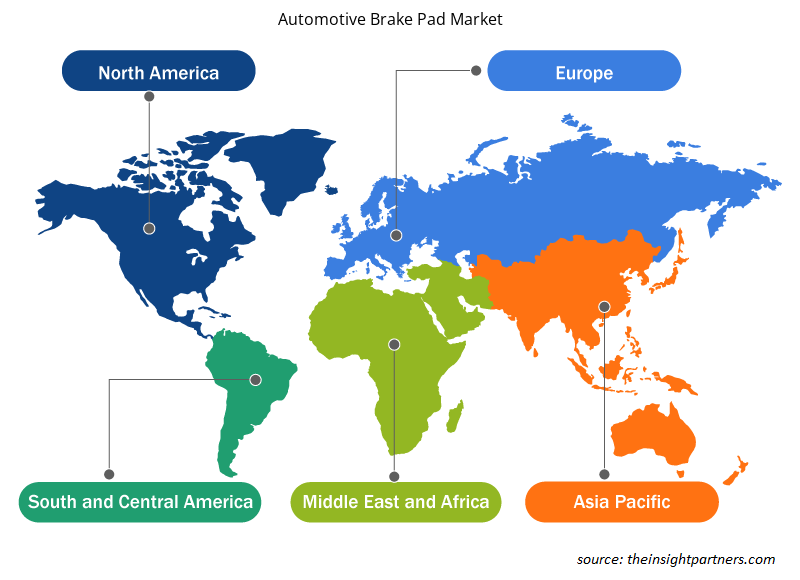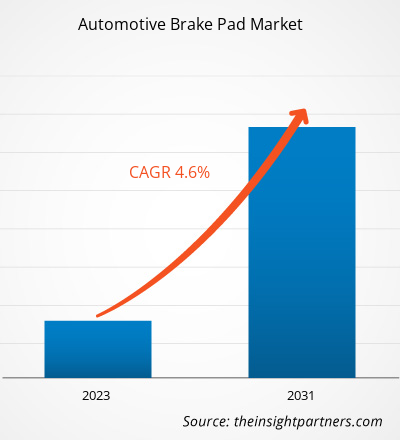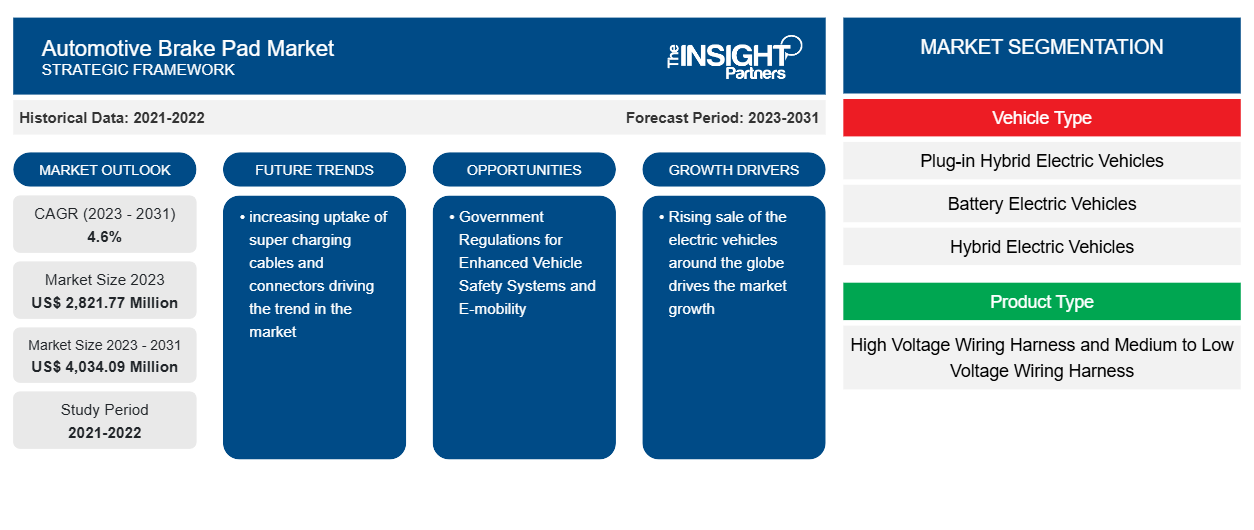Se proyecta que el tamaño del mercado de pastillas de freno para automóviles alcance los 4.034,09 millones de dólares estadounidenses en 2031, frente a los 2.821,77 millones de dólares estadounidenses en 2023. Se espera que el mercado registre una CAGR del 4,6 % durante el período 2023-2031. La creciente venta y producción de vehículos comerciales y de pasajeros impulsa la tendencia en el mercado.
Análisis del mercado de pastillas de freno para automóviles
Los avances tecnológicos en los sistemas electromecánicos y de refuerzo, el aumento del uso de vehículos de mayor rendimiento y el aumento de la demanda de frenos de disco para proporcionar una mayor seguridad están impulsando el crecimiento del mercado de frenos de disco para automóviles. Sin embargo, el alto coste de fabricación de los frenos de disco puede frenar el crecimiento de este mercado. Además, se prevé que el aumento del uso de frenos de disco neumáticos en vehículos comerciales y la creciente adopción de pastillas de freno de cerámica de carbono creen oportunidades de mercado para los frenos de disco para automóviles durante el período de pronóstico.
Descripción general del mercado de pastillas de freno para automóviles
Los actores clave en el ecosistema del mercado global de frenos de disco para automóviles incluyen proveedores de hardware/componentes, fabricantes de frenos de disco para automóviles, organismos normativos y reguladores y usuarios finales. Los proveedores de componentes/hardware proporcionan diversos componentes/partes/materias primas a los fabricantes de frenos de disco para la fabricación del producto final. Pastillas de freno, tornillo de purga, pinzas, rotores y hardware.
El freno de disco está hecho de hierro fundido, aluminio, acero inoxidable y muchos más. Algunos de los principales actores/fabricantes del mercado mundial de frenos de disco para automóviles incluyen a Thermo Fisher Scientific Inc., Brembo SPA, Continental AG, Knorr-Bremse Group y Robert Bosch GmbH, entre muchos otros. Las pastillas de freno se utilizan principalmente en automóviles de pasajeros, sin embargo, debido a su rendimiento estable en resistencia al frenado y velocidades más altas, se están extendiendo al segmento de vehículos comerciales. En los vehículos comerciales, los frenos de tambor están siendo reemplazados por frenos de disco, ya que brindan una mayor calidad y una vida útil más prolongada. Empresas como Akebono también ofrecen frenos de disco.
Personalice este informe según sus necesidades
Obtendrá personalización en cualquier informe, sin cargo, incluidas partes de este informe o análisis a nivel de país, paquete de datos de Excel, así como también grandes ofertas y descuentos para empresas emergentes y universidades.
-
Obtenga las principales tendencias clave del mercado de este informe.Esta muestra GRATUITA incluirá análisis de datos, desde tendencias del mercado hasta estimaciones y pronósticos.
Factores impulsores y oportunidades del mercado de pastillas de freno para automóviles
El creciente número de accidentes de tráfico en todo el mundo y el aumento de la congestión del tráfico impulsan el crecimiento del mercado
Existen otros actores periféricos involucrados en el mercado que desempeñan un papel crucial para permitir el crecimiento y los avances tecnológicos relacionados con los frenos de disco para automóviles. El creciente número de accidentes de tráfico debido a los vehículos está creando la necesidad de normas de seguridad, lo que fomenta la necesidad de normas sobre sistemas de frenado y seguridad vial. Según la Organización Mundial de la Salud, alrededor de 1,19 millones de personas mueren cada año. Los principales usuarios finales del mercado de pastillas de freno para automóviles incluyen automóviles de pasajeros y vehículos comerciales. Además, el aumento de los problemas de congestión del tráfico en las áreas urbanas de todo el mundo impulsa la demanda de productos de pastillas de freno para automóviles durante el período de pronóstico.
El aumento de las ventas de vehículos eléctricos creará amplias oportunidades para el crecimiento del mercado
Los vehículos eléctricos utilizan pastillas de freno para cumplir con los requisitos de frenado de los vehículos. Las pastillas de freno ayudan a evitar accidentes. Con el creciente crecimiento de la industria de los vehículos eléctricos (VE), la adopción de sistemas de frenado está creciendo exponencialmente. Con el objetivo de reducir el impacto nocivo de las emisiones en el medio ambiente, los organismos gubernamentales que operan a nivel mundial están tomando las medidas necesarias para promover los vehículos eléctricos. Por ejemplo, la Iniciativa de Vehículos Eléctricos es un foro de políticas multigubernamental que fomenta la introducción y adopción de vehículos eléctricos. Con un aumento en el uso de vehículos eléctricos, el alcance del uso de sistemas de frenado avanzados también aumentará. Muchos autos eléctricos utilizan sistemas de frenado regenerativo y mecánico juntos. En un sistema de freno de un auto eléctrico, los sistemas de frenado regenerativo y mecánico ayudan a ahorrar energía.
Análisis de segmentación del informe de mercado de pastillas de freno para automóviles
Los segmentos clave que contribuyeron a la derivación del análisis del mercado de pastillas de freno automotrices son el tipo de material, el tipo de vehículo y la geografía.
- Según el tipo de material, el mercado se divide en pastillas de freno metálicas, pastillas de freno semimetálicas, pastillas de freno de cerámica, pastillas de freno de amianto y pastillas de freno orgánicas sin amianto. Entre estas, las pastillas de freno metálicas tienen la mayor participación en 2023, esto se debe al aumento de la demanda en los automóviles de pasajeros en todo el mundo.
- Dependiendo del tipo de vehículo, el mercado se divide en vehículos comerciales y turismos. Entre estos, el segmento de turismos tiene una mayor participación en 2023, esto se debe a la cantidad de turismos que se venden en todo el mundo. Según la Organización Internacional de Fabricantes de Vehículos de Motor, las ventas de turismos a nivel mundial alcanzaron los 65,2 millones de unidades en 2023, frente a los 58,6 millones de unidades en todo el mundo.
Análisis de la cuota de mercado de las pastillas de freno para automóviles por geografía
El alcance geográfico del informe del mercado de pastillas de freno automotrices se divide principalmente en cinco regiones: América del Norte, Asia Pacífico, Europa, Medio Oriente y África, y América del Sur y Central.
Se considera que la región de Asia Pacífico es la que crece más rápidamente, y China y la India ocupan el primer y tercer lugar en el mundo. Japón es el país tecnológicamente más avanzado de la región, lo que ofrece una oportunidad para el desarrollo del mercado de neumáticos para automóviles. Las economías emergentes del sudeste asiático, como Vietnam, Malasia e Indonesia, están experimentando un crecimiento en las ventas de automóviles, por lo que se prevé que aumente la demanda de pastillas de freno para automóviles.
América del Norte está creciendo a un ritmo rápido debido al aumento de las ventas de automóviles en Estados Unidos y Canadá. El Tratado de Libre Comercio de América del Norte (TLCAN) es un acuerdo firmado entre Estados Unidos, Canadá y México. Este ha reducido la mayoría de las barreras arancelarias y no arancelarias al libre comercio y la inversión entre los tres países. Esto ha ayudado aún más a aumentar el nivel de comercio e inversión en los países de América del Norte. Además, México está surgiendo como una potencia en la fabricación de automóviles del TLCAN, suministrando piezas por un valor de más de 4.300 millones de dólares y vehículos terminados por un valor de 2.600 millones de dólares cada mes a Estados Unidos desde hace algunos años.
Perspectivas regionales del mercado de pastillas de freno para automóviles
Los analistas de Insight Partners explicaron en detalle las tendencias y los factores regionales que influyen en el mercado de pastillas de freno para automóviles durante el período de pronóstico. Esta sección también analiza los segmentos y la geografía del mercado de pastillas de freno para automóviles en América del Norte, Europa, Asia Pacífico, Oriente Medio y África, y América del Sur y Central.

- Obtenga datos regionales específicos para el mercado de pastillas de freno para automóviles
Alcance del informe de mercado de pastillas de freno para automóviles
| Atributo del informe | Detalles |
|---|---|
| Tamaño del mercado en 2023 | US$ 2.821,77 millones |
| Tamaño del mercado en 2031 | US$ 4.034,09 millones |
| CAGR global (2023 - 2031) | 4,6% |
| Datos históricos | 2021-2022 |
| Período de pronóstico | 2023-2031 |
| Segmentos cubiertos |
Por tipo de vehículo
|
| Regiones y países cubiertos |
América del norte
|
| Líderes del mercado y perfiles de empresas clave |
|
Densidad de actores del mercado: comprensión de su impacto en la dinámica empresarial
El mercado de pastillas de freno para automóviles está creciendo rápidamente, impulsado por la creciente demanda de los usuarios finales debido a factores como la evolución de las preferencias de los consumidores, los avances tecnológicos y una mayor conciencia de los beneficios del producto. A medida que aumenta la demanda, las empresas amplían sus ofertas, innovan para satisfacer las necesidades de los consumidores y aprovechan las tendencias emergentes, lo que impulsa aún más el crecimiento del mercado.
La densidad de actores del mercado se refiere a la distribución de las empresas o firmas que operan dentro de un mercado o industria en particular. Indica cuántos competidores (actores del mercado) están presentes en un espacio de mercado determinado en relación con su tamaño o valor total de mercado.
Las principales empresas que operan en el mercado de pastillas de freno para automóviles son:
- Coroplast Fritz Müller Gmbh & Co. Kg
- Fujikura Ltda.
- Compañía Eléctrica Furukawa Ltd.
- Sistemas de Sumi de Motherson Ltd.
- Nexans Autoelectric GmbH
- Compañía Electrónica Sinbon
Descargo de responsabilidad : Las empresas enumeradas anteriormente no están clasificadas en ningún orden particular.

- Obtenga una descripción general de los principales actores clave del mercado de pastillas de freno para automóviles
Noticias y desarrollos recientes del mercado de pastillas de freno para automóviles
El mercado de pastillas de freno para automóviles se evalúa mediante la recopilación de datos cualitativos y cuantitativos posteriores a la investigación primaria y secundaria, que incluye publicaciones corporativas importantes, datos de asociaciones y bases de datos. A continuación, se enumeran algunos de los desarrollos en el mercado de pastillas de freno para automóviles:
- Delphi anuncia el lanzamiento de su nueva gama de pastillas de freno para vehículos eléctricos (BEV) dedicada a las necesidades específicas de las aplicaciones de vehículos eléctricos. Según comparaciones detalladas, esta gama se encuentra entre las más completas del mundo en la actualidad y abarca los modelos más populares en el mercado de repuestos independiente. Los vehículos incluyen el Nissan Leaf y el Tesla Model S/Model 3, además de los modelos más nuevos, como el BMW i4/iX, el Mercedes EQC/EQEE/QS y el Porsche Taycan/Cross Turismo. Con la introducción de 52 números de pieza que cubren 2,7 millones de vehículos en funcionamiento en Europa, Delphi ofrece una importante oportunidad de servicio para los talleres. (Fuente: sitio web de la empresa, febrero de 2024)
- Allied Nippon lanzó EV+, una gama de pastillas de freno completamente nueva y con todas las funciones para vehículos eléctricos. (Fuente: Comunicado de prensa, junio de 2023)
Informe sobre el mercado de pastillas de freno para automóviles: cobertura y resultados
El informe “Tamaño y pronóstico del mercado de pastillas de freno para automóviles (2021-2031)” proporciona un análisis detallado del mercado que cubre las siguientes áreas:
- Tamaño del mercado de pastillas de freno para automóviles y pronóstico a nivel mundial, regional y nacional para todos los segmentos clave del mercado cubiertos bajo el alcance
- Tendencias del mercado de pastillas de freno para automóviles, así como dinámica del mercado, como impulsores, restricciones y oportunidades clave
- Análisis PEST y FODA detallados
- Análisis del mercado de pastillas de freno para automóviles que cubre las tendencias clave del mercado, el marco global y regional, los principales actores, las regulaciones y los desarrollos recientes del mercado.
- Análisis del panorama de la industria y de la competencia que abarca la concentración del mercado, el análisis de mapas de calor, los actores destacados y los desarrollos recientes del mercado de pastillas de freno para automóviles
- Perfiles detallados de empresas
- Análisis histórico (2 años), año base, pronóstico (7 años) con CAGR
- Análisis PEST y FODA
- Tamaño del mercado, valor/volumen: global, regional y nacional
- Industria y panorama competitivo
- Conjunto de datos de Excel
Informes recientes
Testimonios
Razón para comprar
- Toma de decisiones informada
- Comprensión de la dinámica del mercado
- Análisis competitivo
- Información sobre clientes
- Pronósticos del mercado
- Mitigación de riesgos
- Planificación estratégica
- Justificación de la inversión
- Identificación de mercados emergentes
- Mejora de las estrategias de marketing
- Impulso de la eficiencia operativa
- Alineación con las tendencias regulatorias























 Obtenga una muestra gratuita para - Mercado de pastillas de freno para automóviles
Obtenga una muestra gratuita para - Mercado de pastillas de freno para automóviles